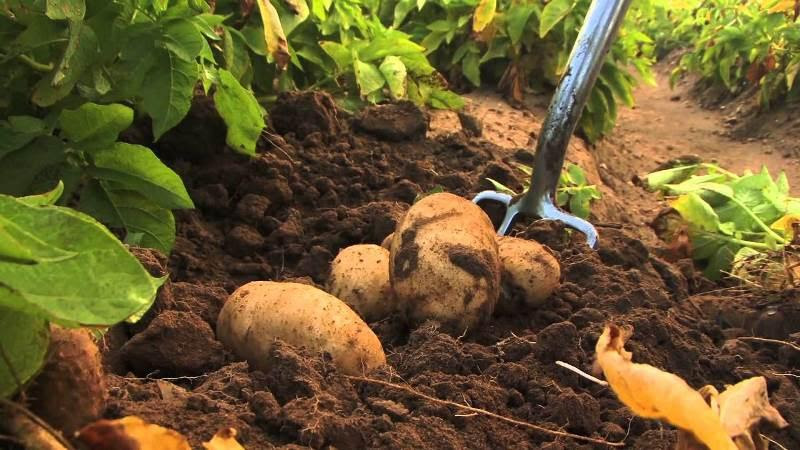
If you want to know about Potato Cultivation, then this blog is just for you.
Potatoes are a highly consumed vegetable worldwide. This veggie belongs to America but is now grown all over the World. It is the most economical food and is considered as the friend of poor men. Similarly, potatoes have a special place in India, and most people consume this tasty food. Therefore, it has high demand among the Indian people. Due to the same, potatoes have been cultivated in the country for more than 300 years. Consequently, it is one of the most popular crops in India.
Potatoes are a high source of starch, vitamins, especially C and B1 and minerals. Thus, they give a source of low-cost energy to the human diet. Potatoes are used for various industrial purposes, such as for the creation of starch and alcohol. Potato starch (Farina) is used in clothes and for sizing yarn in textile mills. Potatoes are also used for the making of dextrin and glucose. As a food product itself, potatoes are converted into dried goods such as ‘potato chips’, ‘sliced’ or ‘shredded potatoes’.
Potato Cultivation Guidance
Potato cultivation is the most profitable farming business, which helps to earn highly. So for the same, new farmers also want to engage in this. Nowadays, a large number of new farmers prefer it highly. They do not have to do more for this farming purpose. However, they need a powerful tractor like Mahindra Tractor 575 and others. So, for them, here we bring detailed information about potato cultivation.?
Check out the step by step guidelines for potato cultivation for new farmers in the below section.
Soil
The potato can be grown on any type of soil except alkaline and saline soils. Naturally, loose soils offer the least resistance to the expansion of the tubers is preferred. Sandy loam and loamy soils, rich in organic matter with good drainage and aeration, are most suitable for growing potatoes. The soil with a pH limit of 5.2-6.4 is considered to be ideal.
Land Preparation
The ground is ploughed at a depth of 24-25 cm and shown to the sun. The soil should have a larger pore space and offer the least resistance to tuber growth. Well decomposed is mixed with the soil during the last ploughing. Farmers do these operations with the help of powerful tractors like Farmtrac 6055 powermaxx and others.
Season of planting
We can produce potatoes only under such conditions where the temperatures during the developing season are slightly cool. Therefore, the sowing time varies from area to area. For example, in the hills of Himachal Pradesh and Uttar Pradesh, the spring crop is sown from January-February while the summer crop is planted in May. In Haryana, Punjab, Uttar Pradesh, Bihar and West Bengal, the spring crop is sown in January, while the main crop is in the 1st week of October. In Madhya Pradesh, Maharashtra and Karnataka, the Kharif crop is buried by the end of June, while the rabi crop is sown from mid-October-November.
Method of Planting
Trenches are opened at a distance of 50-60 cm before sowing. The whole or cut tubers are located 15- 20 cm apart on the middle of the ridge at a base of 5-7 cm and covered with soil. The seed rate of potatoes depends upon the planting season, duration, seed size, spacing etc. The seed rate is 1.5-1.8 t/ha for round groups and 2.0-2.5 t/ha for oval varieties. A four-row automatic potato planter developed by ICAR-CPRI (Central Potato Research Institute ) performs all the operations from ridging to seeding and covers an area of 4-5 hectares per day. The tuber loss is as low as 1%, while it requires only 2-3 persons for the whole operation.
Weed Control
The potato crop increases canopy in about 4 weeks after planting, and we must regulate weeds to gain a competitive benefit for the crop. If the weeds are vital, we should remove them before the ridging operations begin. Remove mechanical or herbicide application after earthing up the weeds among the growing plants and at the top of the ridge. We can do a wedding manually; however, it is expensive. Hence, an animal-drawn three-tine cultivator is used, which can cover one hectare per day. Alternatively, pre-emergence spraying of weedicides such as Flucholralin or Pendimethalin is recommended for controlling yearly grass weeds and broadleaf plants.
Earthing up
The primary purpose of earthing up is to have the soil loose and destroy weeds. We should do two or three earthing up at an interval of 15-20 days. The first earthing-up is when the plants are about 15-25 cm high. The second earthing up is often to cover up the tubers adequately. Use of double mouldboard plough ridge or 3 and 5-row tractor-drawn culti-ridger can accomplish the earthing.
Crop Rotation
The cropping Rotation is as follows.
Punjab: Potato-Wheat-Maize, Potato-Wheat-Paddy, Potato-Wheat-Green manure crop
Assam: Potato-Mung-Paddy (Transplanted)
Bihar: Potato-Mung- Paddy; Potato-Mung-Groundnut
Madhya Pradesh: Potato-Okra-Soybean
Gujarat & Uttar Pradesh: Potato-Bajra-Groundnut
Intercropping
Potato being a short time and the fast-growing crop is an ideal crop for intercropping with other crops. For example, it can be successfully intercropped with sugarcane, as both crops’ improving operations and resources are mutually interdependent. The potato-onion and potato-fennel intercropping in Haryana, potato-linseed and potato-mustard in Uttar Pradesh, and potato-wheat intercropping in Bihar are some of the valuable crop combinations.
We hope now you can practice potato farming. Stay with us for more farming tips.

As the editor of the blog, She curate insightful content that sparks curiosity and fosters learning. With a passion for storytelling and a keen eye for detail, she strive to bring diverse perspectives and engaging narratives to readers, ensuring every piece informs, inspires, and enriches.









